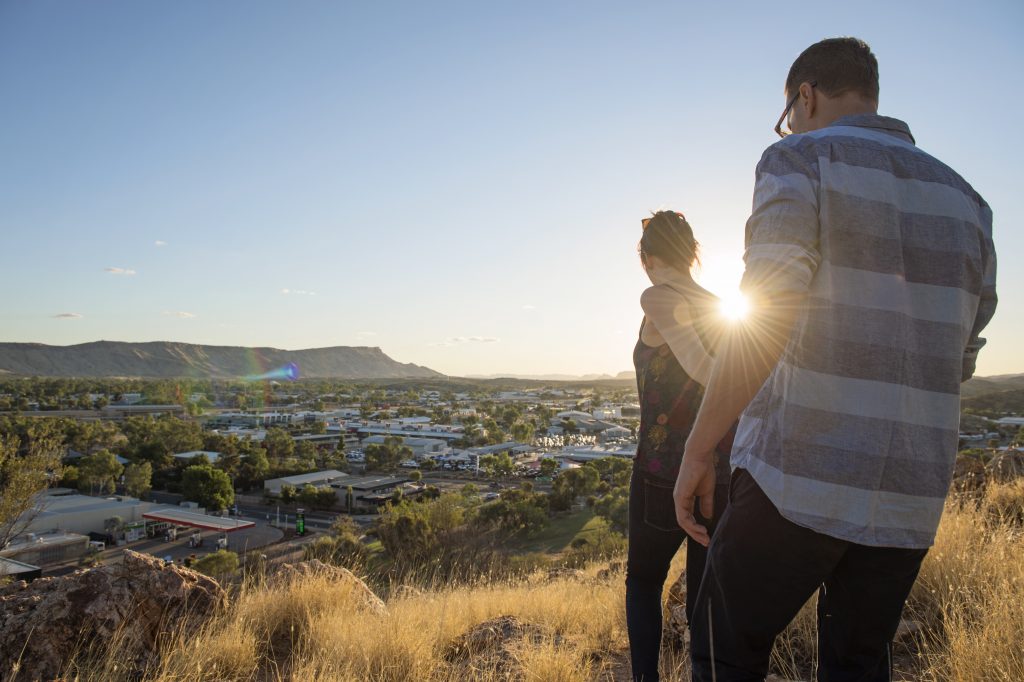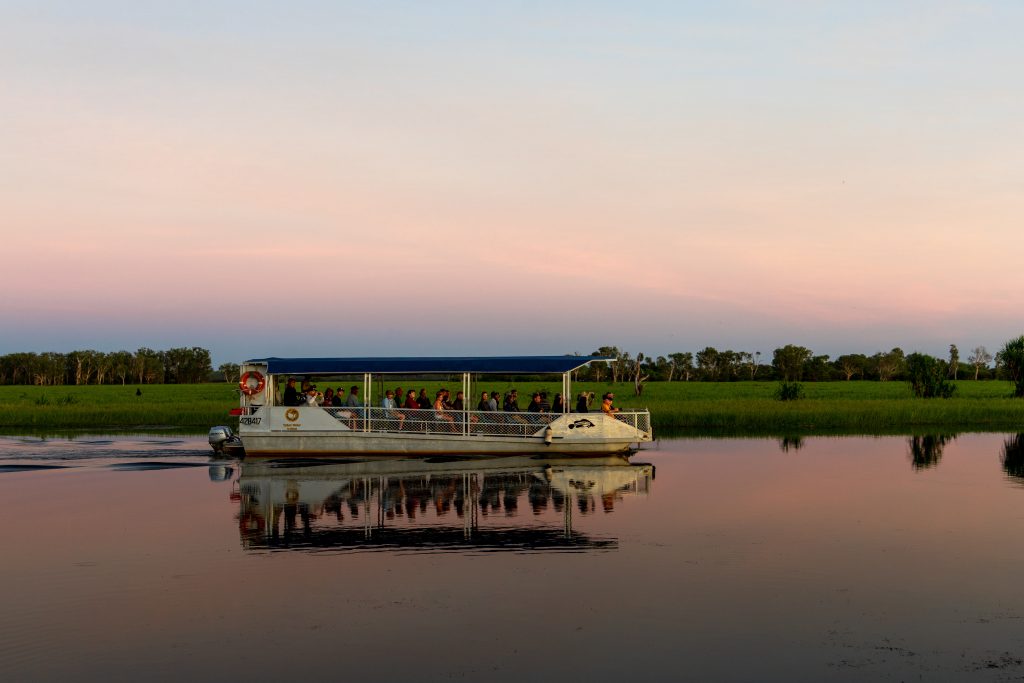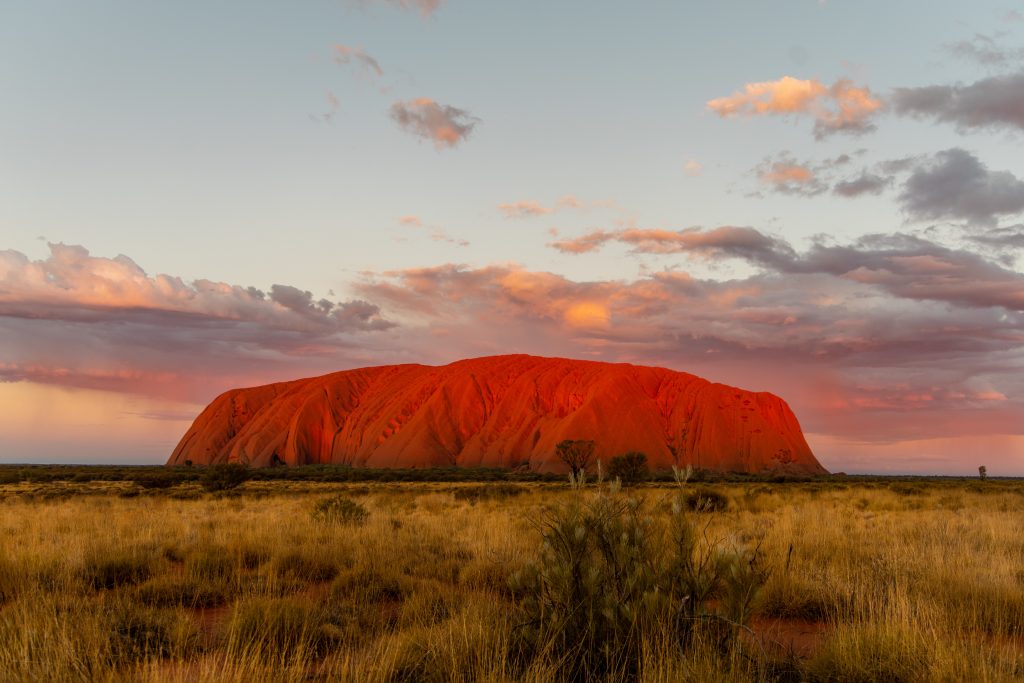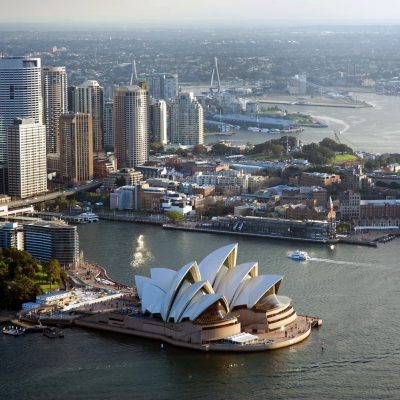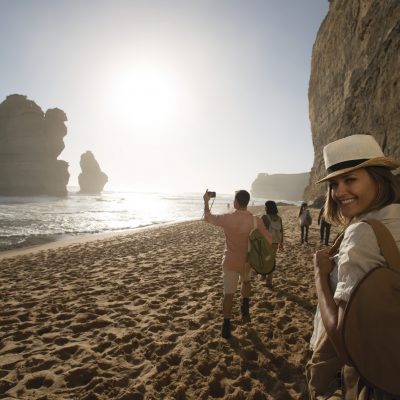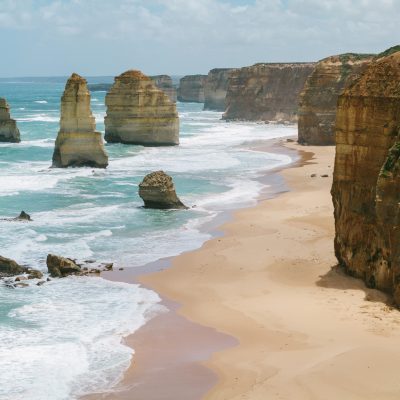From the wetlands of the Kakadu National Park to rugged West MacDonald Ranges and Sweeping Landscapes of Ayers Rock and the Olgas. Enjoy the Best of the Northern Territory in this 10 Day Top End and Red Centre Self Drive.
Darwin NT, Australia
-
There’s a lot to see on the road between Darwin and Kakadu National Park so an early start is recommended. Departing Darwin, travel to Kakadu National Park. Kakadu is one of four Australian sites included on the World Heritage List for both cultural and natural outstanding universal values. The park features great natural beauty and sweeping landscapes, as well as internationally important wetlands.
You may wish to visit the Window on the Wetlands Visitors Centre, which is about 10km (6 miles) along the Highway near Beatrice Hill. This interpretive centre provides visitors with a fascinating insight into the animal and bird life of this sensitive ecological region of the Adelaide River Wetlands.
At Nourlangie Rock the walls of the rock shelter have served as canvases for thousands of years, providing windows to a rich spiritual tradition. Paintings such as Namarrgon, the Lightning Man, explore the relationship of the people to their country and beliefs. During the dry season, park rangers invite you to join them and share their in-depth knowledge of this ancient gallery.
Continue south west to your Cooinda accommodation for the next two nights.
-
In Cooinda, you will enjoy an early morning 2hr Yellow Water Cruise on Kakadu’s most famous wetland area, located on the South Alligator flood plain. It is a pristine environment which supports a wonderful variety of plants, birds, crocodiles and many animals. Your will have the rest of the day to explore at leisure, before continuing your journey to Katherine the following day.
The rest of the day is at leisure for you to explore. The Warradjan Aboriginal Cultural Centre is located less than 1 kilometre by road or 15 minutes walk from the lodge and offers a walk through an Aboriginal cultural display area, cinema shows and an Aboriginal arts and craft shop.
-
After an early departure, you will continue along the Stuart Highway today and be sure to stop at Edith Falls signs to Edith Falls. Edith Falls is part of the Nitmiluk National Park and consist of a series of falls on the edge of the Arnhem Land escarpment. The Nitmiluk (Katherine Gorge) National Park consists of 13 natural gorges and is a massive 292,008 hectares in size.
The Gorge is where the Katherine River, after beginning in the wild escarpment country of Arnhem Land, flows through 13 spectacular gorges before heading northwest to the tidal Daly River and the Timor Sea. Boat cruises and canoeing is another popular way to see the gorge system. Due to the abundance of water, the Park is vibrant with life, not only Barramundi and freshwater crocodiles, but rare birds like crimson and Double-barred Finches, as well as goannas, bats and wallabies.
You will arrive into the town of Katherine in the late afternoon. Katherine is the Top End’s second largest town. . Its river – the first perennial running water along the route from Alice Springs – was originally dubbed the ‘Catherine’ by John McDouall Stuart in 1862, after his patron’s daughter. The spelling was changed and the town of Katherine was eventually settled to service the Overland Telegraph Line.
After the establishment of its pastoral industry by early pioneers, Katherine became a WWII defence force base like so many others in the Territory. It even suffered an air raid by nine Japanese bombers in 1942. Katherine has held on to its military heritage by becoming home to the Tindal RAAF base.
-
A big day of driving today so again a very early start is recommended.
Continue south along the Stuart Highway through to Mataranka, a welcome stop for all travellers, as it boasts a great and soothing thermal pool. The pool is a constant 34 degrees Celsius and flows from Rainbow Springs at an amazing rate of 30.5 million litres a day. Guests will also enjoy a stop at the Daly Waters Pub, the oldest pub in the Northern Territory. For the aviation aficionados, this little town doesn’t disappoint, as Daly Waters also have the distinction of being Australia’s first international airfield. The original QANTAS hangar and associated buildings located between the town and the Stuart Highway are still there today.After a long drive through the outback landscape, you will arrive at Tennant Creek where you will spend the night. The Tennant Creek region is traditional Warumungu country, and today many Aboriginal tribes make it their home. You can learn about Aboriginal culture from murals around the town, or visit the Aboriginal art gallery, and meet some of the people as they create their paintings and objects.
Today, Tennant Creek is central Australia’s second largest town and home to 4000 people. The township of Tennant Creek is a modern outback gold mining town and the centre for the Barkly pastoral industry. The Creek itself is 12kms (7 miles) north of the town, and this is where the Overland Telegraph Station was built in 1872. The historic stone buildings can still be visited today.
-
An early departure is recommended this morning for the long drive south along Stuart Highway to Alice Springs. Along your way you will come to one of the Territory’s most well known landmarks – the extraordinary, balancing Devils Marbles. Thousands of enormous precariously balanced boulders make the Devils Marbles Conservation Reserve the region’s most spectacular landmark.
When you arrive in Alice Springs, you may be expecting to find a quiet old country town but in fact what you will find is a bustling township of more than 25,000 friendly Territorians with every service and facility you could want. There are also several you will probably not be expecting – like a casino, an arts and entertainment centre, date and camel farms, a winery, a picturesque golf course and hot-air ballooning, just to name a few.
Alice Springs has been an important stop for travellers since the early Overland Telegraph days of the 1800s. Today ‘The Alice’ has developed into such a significant town that it is more than just an oasis in the Outback. The early history of Alice Springs is carefully preserved in several museums. During your day at leisure, a suggested visit to the School of the Air and the Royal Flying Doctor Service will show you two of the facilities necessary for everyday life in remote locations.
Aboriginal culture has been an important part of Central Australia for at least 50,000 years and the galleries in Alice Springs provide plenty of opportunities to view and purchase some original art and craft from local Indigenous artists.
-
Today is at leisure for you to explore Alice Springs and surroundings. The most visited landmark in Alice Springs is Anzac Hill and is the ideal spot for an overview of the town and an amazing photo opportunity. The lookout offers a panoramic view of Alice Springs and the beautiful surrounding ranges. The Anzac Hill Memorial was unveiled on 25 April 1934 (Anzac Day) and was originally dedicated to all those members of the armed services who had paid the supreme sacrifice during World War I. It has now become a memorial to all those who have served in the defence of their country during all wars in which Australia has participated.
-
Depart Alice Springs this morning and travel via Erldunda to Kings Canyon.Once at Kings Canyon, the views from the Canyon rim are magnificent. The spectacular scenery, an eerie collection of weathered rock formations known as the Lost City, and an oasis with a permanent waterhole veiled by palms and ferns known as the Garden of Eden, combine to make Kings Canyon a most unexpected surprise.
There are several ways you can explore it. Its well worth taking the 6km (3.7 mile) return walk to the rim of the Canyon, as the views from the 300 metre drop to the valley floor are breathtaking. The walk takes you through the Garden of Eden, just one hour’s walk from the car park. The area of the Park has been the home of the Luritja people for the last 20,000 years. Their word, Watarrka, refers to the umbrella bush that proliferates here. In fact, this area has over 600 different plant species.
Enjoy your evening at the accommodation over a glass of wine with dinner.
-
You will make your way from Kings Canyon Resort this morning to the world’s most famous monolith, Uluru (Ayers Rock). The Rock has its moods – changing colour depending on the time of day. At sunset and Sunrise you can see the whole gamut when Ayers Rock/Uluru puts on a light show that changes its colours from red to orange to lilac in a matter of minutes.
Its important Aboriginal history means that the National Park is one of only two places in the world recognised as a World Heritage site because of its living cultural significance. It is jointly managed according to the rules of Anangu Law, the Tjukurpa. Not surprisingly, it has a significant place in the Anangu’s creation stories and laws and many of these stories relate to how the ancestral beings formed the Rock.
This evening you will enjoy a magical 3 course ‘Sounds of Silence’ buffet dinner with the ‘Rock’ as your backdrop. Truly an amazing experience and memory your will carry with you forever.
-
Today is at leisure for you to explore Ayers Rock & surroundings. There are many options available for you to enjoy, including daily sunrise or sunset tours, camel rides or even an experience on a Segway around the base of the ‘Rock’. These can be requested with a bespoke itinerary.
-
The following day, return your vehicle at Ayers Rock airport for your departure.



